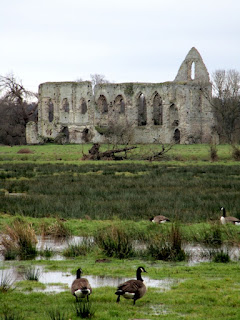The tube strike scuppered my aim to go to London to visit a suburban museum or two last week, but rather keen on a change of scene of any kind I set off for a walk around the footpaths south of Woking. The aim was to have my sandwich at the ruins of Woking Old Palace. But first having parked near Newark Lock on the Wey Navigation I found myself having to negotiate paths which were really no longer paths, but pools and occasionally flowing streams. Sometimes walking straight through the middle was the safest bet as you were still treading on what was a path underneath the water, whereas straying to either side took you into marsh of uncertain solidity and depth. Most of the time my boots were proof against this treatment, until the one occasion when I completely misjudged what I was treading on and found my leg in water up above the knee.
Woking Old Palace is not all that prepossessing, a couple of medieval walls set into the remains of a later brick barn, but even if the weather is dull you can sit, eat, and contemplate the marshes, checking that the planes going overhead are ordinary passenger flights and not fighter jets.
From there I squelched towards Woking town. My destination was the wonderful Lightbox, the museum-cum-gallery I've visited several times before. It was time to renew my acquaintance with its striking displays which pack the whole history of the town very effectively into a single room, and, just as importantly, with its tea shop.
I returned via a different route avoiding the damp problems of the outward journey, observing the geese enjoying their waterlogged surroundings in the shadows of Newark Abbey.
Driving out to Newark earlier on, much to my surprise I found St Mary Magdalene's, Ripley, open. Ripley was a four-star church in 1973, so this was a worthwhile addition to the visiting list. The only sign of obvious Catholic identity now is the aumbry (you may note the lack of lamp) and, near it, a little statue of the BVM looking a tad embarrassed at being there; the nice Gothic panel on the wall seems to serve no clear purpose beyond the decorative. As often happens, the Lady Chapel, with its altar reredos that looks a little like a bedhead, was given as a result of World War One, but unusually as a thank offering for someone returning safely than a memorial to someone who didn't. And - a specially delightful bonus! - there is a window of St Catherine, looking very placid and ethereal on this occasion.








No comments:
Post a Comment